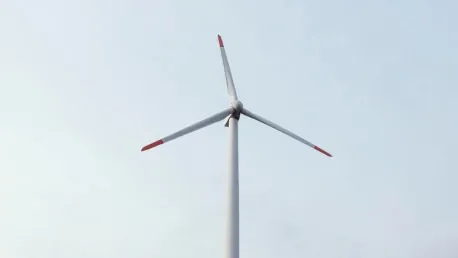The United Kingdom recently witnessed a significant drop in energy prices, thanks to unprecedented levels of wind-generated electricity. On a notable evening, wind power surged to a record peak output, generating 22.4 gigawatts (GW). This contribution accounted for over 68% of Britain’s power needs, surpassing prior records and leading to a substantial dip in half-hourly power prices, which fell below zero with a rate recorded at 6.57 pounds per megawatt-hour early Wednesday morning. This surge in wind energy underscores the critical role of renewables in meeting the nation’s energy demands, particularly during the winter months when energy consumption is at its highest.
RenewableUK’s chief executive, Dan McGrail, expressed the importance of this milestone, highlighting wind energy as a cornerstone for the country’s power requirements. Official statistics reinforce this view, showing that renewables have provided more than half of the UK’s electricity for four consecutive quarters. This consistent performance demonstrates how sustainable energy sources have become integral to the nation’s power infrastructure, offering both environmental and economic benefits.
The Impact of Wind Energy on UK Power Prices
Record-Breaking Wind Power Generation
The record-breaking contribution from wind power stations across Northern Ireland and Scotland, in particular, has had a noticeable impact on the UK’s energy pricing structure. On the specific evening in question, wind power generated an impressive 22.4 GW, leading to more than 68% of Britain’s total power need being met by this renewable source. This phenomenon marked the highest-ever output for wind-generated electricity in the country, clearly illustrating the potential of harnessing wind energy on a large scale. The resulting surplus in energy supply caused a significant decrease in half-hourly power prices, demonstrating the financial advantages of robust renewable energy integration.
This spike in wind energy not only resulted in lower energy costs but also highlighted the efficiency and reliability of wind farms in generating large quantities of power. The essential role wind energy played during this period underscores the progress made in expanding and optimizing renewable energy infrastructure. This shift is rapidly contributing to a greener, more sustainable energy portfolio for the United Kingdom, setting a precedent for other nations aiming to reduce their dependence on fossil fuels.
Challenges and Intermittency of Renewable Energy
Despite this remarkable achievement, the UK’s power grid faces challenges due to the inherently fluctuating nature of weather conditions. When wind output is low, the country must heavily rely on gas-fired plants to meet its energy demands, sometimes requiring these plants to supply up to 70% of the nation’s power. This dependency underscores the need for a balanced approach to energy generation, incorporating both renewable sources and traditional power plants to ensure a stable, reliable supply. The intermittency of wind power remains a significant hurdle that the UK must address as it continues to expand its renewable energy capabilities.
To mitigate these challenges, grid operators are working to enhance their energy storage and management systems. The National Grid Electricity System Operator (NESO) has emphasized the importance of expanding battery storage capacity to manage the volatility of renewable energy supply effectively. NESO recommends increasing battery storage by 17 GW, bringing the total to 22 GW, to stabilize the energy grid during periods of low wind output. This strategic investment in energy storage will play a crucial role in ensuring that renewable energy sources remain reliable and consistent contributors to the overall energy mix.
The UK’s Commitment to Renewable Energy Expansion
Ambitious Clean Energy Targets
The UK’s government has committed to significantly bolstering its clean energy infrastructure to transition towards more sustainable power sources. Among their ambitious targets, the government plans to quadruple offshore wind power capacity, double the capacity of onshore wind farms, and triple solar energy capacity by 2030. These goals aim to ensure that 95% of the UK’s energy will originate from green sources, drastically reducing the nation’s carbon footprint and reliance on fossil fuels. Achieving these targets will position the UK as a global leader in the transition to renewable energy, contributing to international climate change mitigation efforts.
These aspirations indicate a proactive approach toward addressing energy security and environmental sustainability. By substantially increasing the capacity for renewable energy generation, the United Kingdom aims to create a more resilient and self-sufficient energy system. The government’s efforts to amplify the development of renewable infrastructure demonstrate a long-term commitment to reducing greenhouse gas emissions and promoting clean energy technologies.
Future Prospects and Global Leadership
The United Kingdom recently experienced a notable decline in energy prices, thanks to a surge in wind-generated electricity. On a notable evening, wind power reached a record peak, producing 22.4 gigawatts (GW). This impressive output supplied over 68% of Britain’s power needs, breaking previous records and causing half-hourly power prices to dip below zero, with a rate of 6.57 pounds per megawatt-hour early Wednesday morning. This increase in wind energy highlights the essential role of renewables in supplying the nation’s energy, especially during winter when consumption peaks.
Dan McGrail, RenewableUK’s chief executive, emphasized the significance of this achievement, identifying wind energy as a key element in meeting the country’s power needs. Official data supports this view, showing that renewables have provided more than half of the UK’s electricity for four straight quarters. This consistent supply demonstrates the growing importance of sustainable energy sources in the nation’s power grid, offering both environmental and financial advantages.









